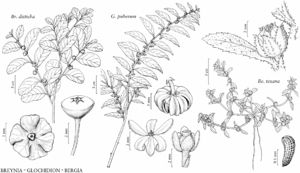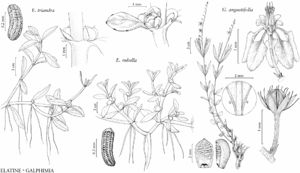Elatinaceae
Herbs [subshrubs], annual [short-lived perennial], synoecious [polygamous]. Leaves opposite [whorled], simple; stipules present; petiole present or absent; blade margins entire or serrulate; venation pinnate. Inflorescences axillary, usually cymes or flowers solitary, sometimes 2[–3]-flowered clusters. Flowers bisexual [pistillate]; perianth and androecium hypogynous; hypanthium absent; sepals 2–5, distinct or connate basally; petals (0 or) 2–5, distinct; nectary absent; stamens [0–]1–10, distinct, free; anthers dehiscing by longitudinal slits; pistil 1, 2–5-carpellate, ovary superior, 2–5-locular, placentation axile; ovules 2–33[–44] per locule, anatropous; styles 2–5, distinct; stigmas 2–5, capitate. Fruits capsules, dehiscence septicidal or irregular. Seeds 2–33[–44] per locule.
Distribution
Nearly worldwide in temperate and tropical regions.
Discussion
Genera 2, species ca. 50 (2 genera, 11 species in the flora).
The affinities of Elatinaceae have long been uncertain; relationships with Caryophyllaceae and Clusiaceae have been proposed (G. C. Tucker 1986). Recent molecular work, combined with a review of morphology, indicates a sister relationship with Malpighiaceae (C. C. Davis and M. W. Chase 2004; K. Wurdack and Davis 2009).
Selected References
Illustrations
Key
| 1 | Sepals 5, carinate; petals 5; inflorescences usually cymes, rarely solitary flowers, pedicels present; plants glandular-pubescent; stems solid or pithy. | Bergia |
| 1 | Sepals 2–4, not carinate; petals (0 or) 2–4; inflorescences solitary flowers, pedicels present or absent, or if flowers 2 per node (E. chilensis) then pedicels absent; plants glabrous; stems with longitudinal air spaces. | Elatine |

